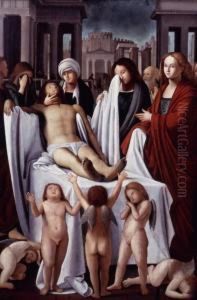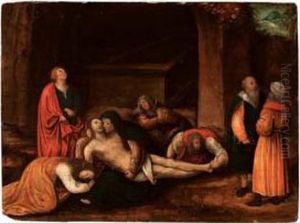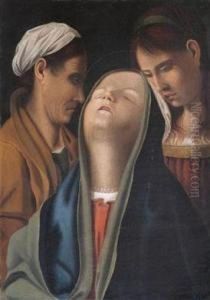Bartolomeo Suardi Paintings
Bartolomeo Suardi, better known by his nickname Bramantino, was an Italian painter and architect active during the High Renaissance. Born in 1474 in Milan, his moniker, Bramantino, meaning 'little Bramante,' is believed to have been derived either from his presumed studies under Donato Bramante or from his stylistic affinity to the famous architect and painter. Bramantino's work is characterized by its innovative use of perspective and architectural elements, which reflect a deep engagement with the ideals of the Renaissance, particularly the interest in harmonizing space, structure, and human figures within a coherent visual order.
Bramantino's early life remains somewhat obscure, but by the early 16th century, he had emerged as a significant figure in Milanese art, receiving commissions from prominent patrons, including members of the Sforza family, the rulers of Milan. His works from this period, such as the 'Madonna of the Pavilion' (c. 1508), showcase his ability to blend architectural precision with a delicate treatment of figures, imbued with a sense of serene spirituality. This painting, among others, illustrates his departure from the more traditional, Gothic styles prevalent in Lombardy to a more modern, Renaissance approach influenced by his studies and observations of contemporary art and architecture.
Apart from painting, Bramantino also contributed to the field of architecture, although fewer records survive of his architectural endeavors. It is known that he was involved in the design of fortifications for the city of Milan under the commission of the Duke of Milan, Ludovico Sforza. His architectural work is noted for its application of Renaissance principles, emphasizing symmetry, proportion, and the use of classical elements.
Bramantino's later works, such as the 'Adoration of the Magi' (c. 1510), display a further maturation of his style, with more complex composition and a greater depth of emotional expression. Despite the high quality of his work, Bramantino did not achieve the same level of fame as some of his contemporaries, such as Leonardo da Vinci or Raphael, partly due to the turbulent political situation in Milan during his lifetime, which often disrupted the arts and patronage.
Bramantino's contributions to the Italian Renaissance, though not as widely recognized as those of some of his peers, remain significant for their artistic innovation and the role they played in the evolution of Renaissance art and architecture in Lombardy. He passed away in 1536 in Milan, leaving behind a legacy that would influence subsequent generations of artists in the region.


